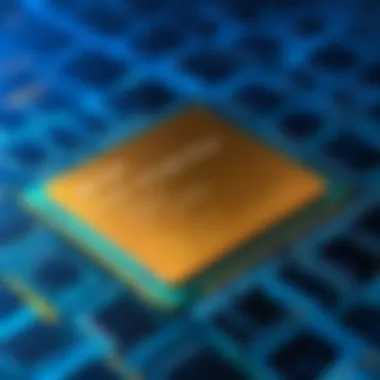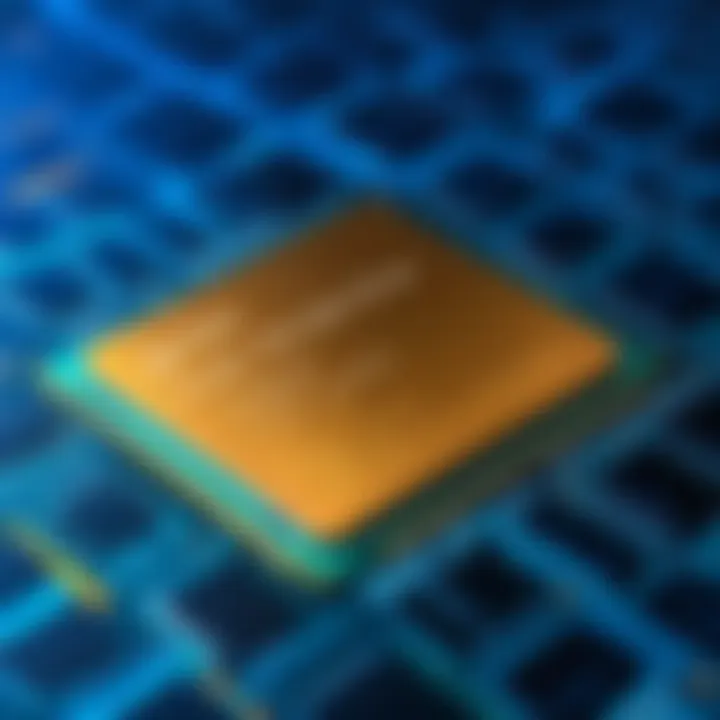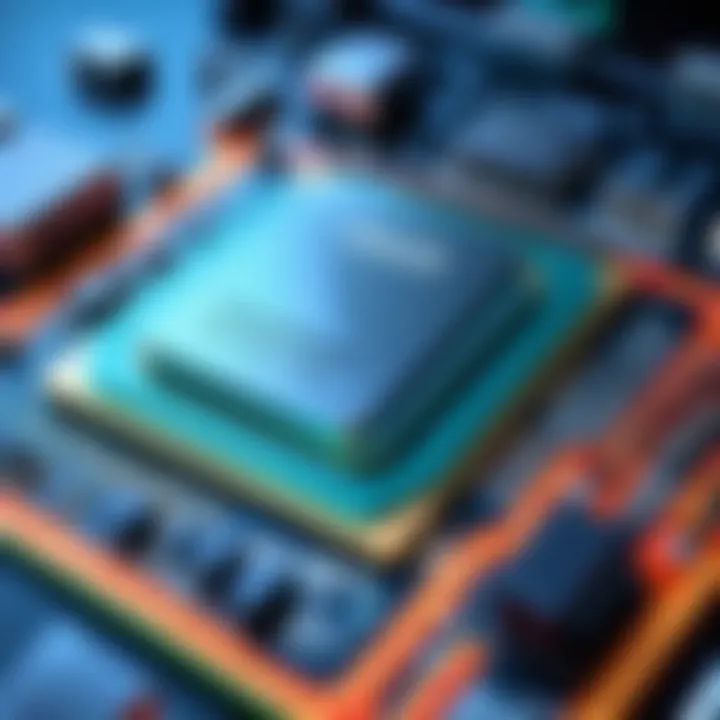Understanding Intel Chipset Pricing Dynamics


Intro
Understanding the intricacies of Intel chipset pricing is no small feat, especially in a market as dynamic as today's tech landscape. The constant tug-of-war between Intel and its rivals, like AMD, shapes not only prices but also consumer's decisions. Factor in regional disparities and emerging technologies, and you have a rich tapestry of influential elements contributing to pricing strategies.
Through this exploration, we'll peel back the layers of Intel's pricing structure, examining how competition, consumer perceptions, and technological innovations play pivotal roles. This narrative aims to offer a thorough understanding that will resonate with tech enthusiasts, gamers, and IT professionals alike.
Product Overview
Brand Information
Intel, a household name in semiconductor manufacturing, has long been championing evidence of operational excellence in the chipset domain. Known for its innovation, Intel consistently strives to integrate cutting-edge technology into their chipsets, catering to both casual users and hardcore gamers.
Key Specifications
Recent Intel chipset offerings, such as the Core i9-12900K and Core i7-12700K, illustrate the blend of performance and efficiency that the company aims for. These models boast increased core counts and support for DDR5 memory, showcasing capabilities that align with modern gaming and intensive computing needs.
Pricing
Now, zooming in on prices, you're likely to spot a broad range aligning with performance. For example, the Core i9-12900K lands with a price a touch above $600, while the i5 models cater to a more budget-friendly demographic, hovering around $200. However, these price points fluctuate frequently due to the aforementioned market dynamics, including supply chain hiccups and competitor offerings.
Performance Comparison
Benchmark Tests
When examining performance, benchmarks are the gold standard. In gaming scenarios, Intel’s recent chipsets often outpace AMD's Ryzen in frame rates, especially in titles optimized for Intel architecture. For instance, tests consistently show that games like "Cyberpunk 2077" run more smoothly on the i9-12900K as opposed to its AMD counterparts.
Speed and Efficiency Comparisons
Efficiency stands tall on Intel's features list, thanks to its hybrid architecture, which optimizes workload distribution between performance and efficiency cores. This not only facilitates snappier responses in multi-threaded tasks but also sustains lower energy consumption under varying loads.
Features and Technology
Unique Features
Some standout features in Intel chipsets include Intel Optane support for improved storage performance and integrated graphics capabilities that lessen reliance on discrete GPUs.
Technological Advancements
The shift towards 10nm SuperFin technology marks a notable milestone for Intel. This iteration has a direct impact on how efficiently CPUs function and dissipate heat, allowing for both better performance and longevity.
Compatibility with Other Devices
Intel chipsets maintain a solid reputation for compatibility with a wide array of devices, from high-end motherboards to budget laptops. This versatility proves appealing to users who want seamless integration across different tech components.
Pros and Cons
Strengths of the Product
- Robust Performance: Intel chipsets often lead in gaming and single-threaded applications.
- Technological Innovation: Frequent updates ensure users get the latest capabilities.
- Wide Compatibility: A diverse ecosystem supports Intel's reach across different platforms.
Areas for Improvement
- Price Volatility: Consumers might find it frustrating as prices can shift overnight.
- Energy Efficiency: Although improving, Intel often trails AMD regarding wattage in certain scenarios.
- Product Availability: Market demand can lead to stock shortages, affecting prices.
Value for Money
Cost-effectiveness
When evaluating cost-effectiveness, one must consider potential resale value. Intel chipsets usually retain their value well due to strong brand loyalty and ongoing demand. This standing can be a comforting factor for those worried about depreciating assets.
Long-term Benefits
Investing in an Intel chipset often pays off in the long run, thanks to the continuing development of software and games optimized for Intel architecture. Users see tangible performance improvements that become justifiable over years of usage.
Comparison with Similar Products


When pitted against AMD products, Intel offers competitive pricing but might sometimes lag in multi-threaded applications. A well-rounded look will reveal that both companies provide compelling options depending on the user’s specific needs and priorities.
Intel's pricing strategy is often a delicate dance balancing innovation with market demand and competition, necessitating continuous adjustments to maintain relevance.
Understanding Intel Chipset Pricing
Gaining a firm grasp of Intel chipset pricing is crucial for several reasons. Firstly, understanding how Intel sets its prices can directly impact consumer decisions, especially for tech enthusiasts and gamers who rely on these chipsets for optimal performance. It's not just about the cost but also the value, longevity, and integration of these components into broader systems.
The nuances in pricing reveal insights into market competition and consumer behavior. Factors such as supply chain intricacies, technological shifts, and even geopolitical events can have a ripple effect on costs, making it essential to keep a finger on the pulse of these developments. When consumers understand these underlying influences, they make decisions that best suit their needs—whether that’s upgrading their gaming rig or choosing components for a work station.
Overview of Intel Chipsets
Intel chipsets serve as the backbone of numerous computing systems, ranging from personal laptops to servers. Each chipset is designed to work seamlessly with specific generations of Intel processors, impacting overall system performance. The Intel 300 series chipsets, for example, support 8th and 9th generation CPUs and are often favored for their robust performance in gaming scenarios.
Chipsets are integral in determining how many ports you can utilize, the speed of data transfer, and even compatibility with various hardware. As technology evolves, so does the architecture behind these chipsets, often leading to significant changes in pricing.
Historical Pricing Trends
Historically, Intel's pricing strategy has evolved alongside the tech landscape. In the early 2000s, chipsets were generally straightforward, with prices influenced heavily by changes in production costs and the tech cycle. For instance, shifting from the socket 478 to LGA 775 introduced new features but also altered the pricing paradigm.
As we progressed into the 2010s, the landscape became more volatile; the rise of competitors like AMD shifted the dynamic considerably. AMD's aggressive pricing strategy during the Ryzen era forced Intel to rethink its approach, causing more fluctuating prices and competitive bundles in the market.
"Understanding the context of historical pricing trends isn't about looking back; it's about making informed decisions for the future."
Looking at recent data, one can observe the pricing spikes around major product launches and shifts in manufacturing. Currently, various chipsets such as the B560, 70, and Z590 families offer a range of prices depending on features like overclocking capabilities and integrated graphics support. Checking historical pricing data is essential to gauge what to expect for upcoming launches, thereby giving consumers the upper hand in making purchasing decisions.
Factors Influencing Price
Understanding the dynamics behind Intel chipset pricing requires a keen eye on various factors that shape these costs. While the allure of performance might drive consumers to select one chipset over another, the price itself plays a significant role in purchasing decisions. To grasp the complexities of this pricing structure, it's essential to dissect the elements that influence costs. In this section, we will analyze three pivotal factors: supply chain considerations, technological advancements, and market demand alongside consumer behavior. Each of these components interlinks and creates a web of influence on chipset pricing.
Supply Chain Considerations
Supply chain dynamics often resemble a tightly wound spool of thread; even the slightest change can unravel the entire structure. In the case of Intel chipsets, various conditions within the supply chain, including vendor relations, logistics, and material costs, dramatically influence overall pricing. For instance, if the semiconductor manufacturing plants in Taiwan face disruptions — which has happened in the past due to natural disasters or pandemic effects — the ripple effect can lead to increased prices worldwide.
Moreover, the sourcing of rare materials required for chipset production, like cobalt and tantalum, adds another layer of complexity. Fluctuations in the costs of these raw materials can directly drive up the prices of chipsets, meaning a consumer could be paying significantly more based on such external factors.
Here are several key points regarding supply chain considerations:
- Vendor relationships are critical. Strong partnerships often lead to better pricing.
- Logistics impacts delivery times and costs; inefficiencies can add to the final price.
- Material costs vary based on global market conditions affecting the whole supply chain.
Understanding these considerations not only helps in comprehending Intel's pricing but also the competitive landscape where prices are adjusted due to external supply pressures.
Technological Advancements
Change is the only constant in technology, and Intel is no stranger to this reality. The pace of innovation in semiconductor technology strongly influences pricing. As new technologies emerge, such as smaller manufacturing processes or enhanced transistor designs, they can motivate Intel to position its pricing strategies competitively. For example, if Intel were to introduce a breakthrough that significantly improves energy efficiency or processing power, they might command a higher price initially as consumers rush to obtain the latest and greatest.
In contrast, once the initial excitement wanes, older models typically see price reductions. This cycle is a double-edged sword; while it can encourage consumers to continually invest in new tech, it can also result in decreased profitability as newer advancements are adopted.
Consider the following points in terms of technological advancements and their effect on pricing:
- New architecture generally demands a premium price due to initial R&D costs.
- Increased competition may drive prices down for older technologies as rivals innovate.
- Market adaptation to new technologies determines consumer willingness to pay.
Consequently, these advancements not only affect prices but also the consumer's perception of value associated with Intel chipsets.
Market Demand and Consumer Behavior
Ultimately, demand does the dance of influence in the pricing landscape. As with any consumer product, pricing strategies often reflect how consumers perceive value, which can fluctuate based on numerous factors including trends, reviews, and regional considerations. For instance, gamers and tech enthusiasts might prioritize performance and be more willing to pay a higher price for a chipset that meets their demands, while casual users might look for more budget-friendly options.
Additionally, seasonal variations, like those during the back-to-school or holiday seasons, can drive demand wildly. Intel may increase prices as the buzz around back-to-school sales begins, capitalizing on heightened consumer engagement. In essence, grasping how consumer behavior shapes demand adds an important dimension to understanding Intel's pricing strategies.
Key insights on market demand and behavior include:
- Trends: Consumer preferences can swing like a pendulum, leading to fluctuating demand.
- Brand loyalty can keep demand steady despite rising prices.
- Market segmentation allows pricing strategies tailored to different consumer groups.
In summary, market demand is not static; it shifts in response to various motivations and perceptions, greatly impacting Intel's pricing structure. Comprehending this interplay provides valuable insight for anyone trying to follow the intricacies of pricing in tech.
Regional Price Variations


Understanding how pricing varies across different regions is crucial when analyzing Intel chipset costs. Geographical distinctions can lead to significant fluctuations in prices, influenced by factors such as local market conditions, consumer preferences, and economic stability. This section outlines these variations, focusing particularly on North America, Asia, and Europe. Insights into local pricing can help consumers and businesses make informed decisions, aligning with budgetary constraints and performance requirements in chipsets.
North America Pricing Landscape
In the United States and Canada, Intel chipsets often stand at a premium when compared to other regions. This is typically due to several contributing aspects:
- Higher Demand: The tech-savvy population and robust gaming community in North America creates a strong demand for advanced processors, often putting upward pressure on prices.
- Regulatory Factors: Tariffs or taxes can influence end-user prices, which may not be the case in other regions that enjoy lower taxes on electronics.
- Retail Competition: While e-commerce giants like Amazon and Newegg foster competition, ensuring better deals, the prices might still rise during peak seasons such as Black Friday or during product launches.
The elevated cost can lead some consumers to explore alternatives like AMD or even older Intel models, illustrating how price sensitivity impacts purchasing behavior.
Asian Markets and Costs
In Asia, the pricing dynamics for Intel chipsets can significantly differ from what’s observed in North America. Here, various elements play a pivotal role:
- Emerging Middle-Class: Countries like India and Vietnam experience rapid economic growth, with an emerging middle-class eager to adopt new technologies. This can cause a spike in demand, pushing prices up.
- Local Manufacturing: Some Asian markets benefit from local assembly lines or manufacturing. This reduces shipping costs and taxes, sometimes translating to lower prices for consumers.
- Flash Sales and Promotions: Platforms like Lazada and Flipkart often engage in aggressive promotional tactics that can alter price perception, offering discounts that may not be available elsewhere.
Overall, while prices for Intel chipsets are generally lower in many Asian markets, spontaneous spikes during festive shopping seasons often disrupt the norm.
Prices in European Markets
Europe presents another nuanced landscape for Intel chipset pricing. Several factors intertwine, creating a patchwork of prices:
- Currency Fluctuations: Variation in currency values, especially between the Euro and the Dollar, can directly impact pricing; a strong Euro can lead to increased prices for imported products.
- Consumer Protections: European laws might impose stricter controls on product pricing, necessitating transparency that can lead to more consistent but sometimes higher prices.
- Regional Tiers: Northern Europe often experiences higher prices compared to Southern Europe, driven by different economic climates and purchasing power dynamics.
In summary, the prices of Intel chipsets across Europe reflect the complexity of regional economic variables, requiring careful consideration for any buyer.
"Regional pricing dynamics teach us that the same product can carry different values based not only on cost but also on desire and cultural contexts."
Considering these variations allows both consumers and tech companies to strategize effectively, ensuring they remain competitive in a fractured market.
Comparative Analysis with Competitors
A comparative analysis of Intel chipsets against its competitors provides essential insights into their pricing strategies and market behavior. This analysis isn’t just a casual observation; it acts as a compelling lens through which the dynamics of the CPU market can be examined. Understanding how Intel stacks up against AMD and other brands can offer tech enthusiasts and IT professionals valuable context when making purchasing decisions or strategizing their upgrading paths.
In the rapidly changing landscape of technology, where innovation drives consumer choices, analyzing competitors helps to identify which features justify higher prices and how well those features meet user needs.
Intel vs. AMD Pricing Strategies
When it comes to pricing, Intel and AMD have distinct strategies that reflect their market positioning and user demographics.
Intel’s Approach: Intel tends to set higher prices on its processors, often justifying this premium through branding and a reputation for stability and performance. The company stresses technological advantages—frequently highlighted are things like higher clock speeds and architecture efficiency. For instance, Intel's Core i9 models command significant premiums due to perceived performance superiority in gaming and content creation. This strategy works wonders in segments where brand loyalty reigns, such as amongst gamers, where Intel has historically held sway.
AMD’s Counter:
Conversely, AMD has carved out a niche with a value-driven approach to pricing. Its Ryzen series often includes more cores and threads at a competitive price point, appealing to users who prioritize multitasking and cost-effectiveness. Games that take advantage of multiple threads may run better on an AMD chip, which is part of their marketing hook. The aggressive pricing of AMD processors can attract budget-conscious consumers, making their offerings increasingly attractive, especially in the face of rising costs of living around the globe.
According to a recent report on tech pricing, Intel's premium pricing might start shifting as AMD continues to gain ground, especially if their architecture improvements keep up. This shift could alter price points in the entire industry.
Market Positioning of Other Brands
While discussing Intel and AMD, it's crucial to acknowledge the competition from other brands such as NVIDIA and ARM, even though they operate in slightly different segments. These companies are also pushing boundaries.
- NVIDIA: While primarily recognized for graphics processing units (GPUs), NVIDIA's influence on chipsets through integrated solutions can't be ignored. Their focus on AI and machine learning capabilities can indirectly affect Intel’s pricing strategy as they provide technological pathways that challenge conventional norms.
- ARM: As major players in mobile and low-power computing, ARM designs chips that are often favored in smartphones and tablets, presenting an emerging challenge to traditional PC chipsets. The growing ecosystem surrounding ARM-based architecture could place pressure on Intel to reconsider its market approach and pricing.
Through the lens of competitive analysis, one can see the price variations are not merely reflections of tech specs but also deeply rooted in branding, market goals, and customer engagement. Businesses and consumers alike need to keep these dynamics in mind. The interplay among these competitors not only shapes individual brand strategies but impacts the entire marketplace, leading to more informed and strategic consumer behaviors.
"In the end, consumers drive pricing as much as brands do—recognizing this symbiosis is key to understanding the market's dynamics."
Combining an understanding of these various pricing strategies gives tech enthusiasts, gamers, and IT professionals the insight they need to navigate the complexities of the current chipset landscape.
Consumer Perception and Buying Decisions
When probing the nuances of Intel chipset pricing, one cannot overlook the pivotal role of consumer perception and purchasing choices. The way buyers perceive Intel’s brand, functionalities, and overall value directly influences their willingness to invest in these products. This section will shape our understanding of how perceptions can shift pricing dynamics and highlight the underlying motivations that steer consumer decisions.
Brand reputation looms large in the tech industry, serving as a double-edged sword for companies like Intel. When shoppers view Intel as a pioneer in technological innovation, they’re often inclined to pay a premium. However, any shift in perception—be it due to emerging competitor offerings or flagged product defects—can swiftly alter consumer behavior. Top-tier brands enchant consumers, yet they remain vulnerable to pitfalls; a single setback can lead to a dip in brand loyalty, affecting pricing strategies immensely.
Understanding consumer sentiment not only impacts immediate purchasing but also influences long-term brand allegiance and market positioning.


Brand Loyalty and Its Impact
Brand loyalty operates somewhat like glue in the consumer electronics arena. It binds a customer to a specific brand, making them resistant to switching to alternatives, even if those alternatives present a more economical choice. With Intel, many users have grown accustomed to its product line; familiarity fosters trust. This loyalty can create a cushioning effect against fluctuating pricing behaviors in the market.
Though loyalty is a powerful force, it is not impervious to change. Factors that sap brand loyalty include:
- Competitive Innovations: AMD and other rivals have broadened their offerings, making some previously loyal Intel customers question their choices.
- Customer Experiences: If consumers face issues with performance or compatibility in Intel products, that frustration can lead them to consider other brands.
- Community Perspectives: Online discussions on platforms like Reddit can rapidly shape brand reputation. If buzz surrounding a product turns negative, those impressions can tarnish loyalty.
"A loyal customer is worth ten advertisements."
While many buyers hold a soft spot for Intel, a robust competitor showing better performance at a lower price point can stir a significant shift in brand perception, thereby influencing overall pricing strategies.
Influence of Reviews and Recommendations
The power of reviews and recommendations in the tech sector cannot be overstated. Potential buyers often look to online reviews as a guiding light to navigate the hazy waters of chipset purchasing. In a world replete with choices, these insights help demystify product offerings, informing and shaping decisions.
Positive reviews often boost demand, causing prices to reflect increased desirability. Conversely, a review that highlights flaws can lead to a price drop; when word spreads about a product's shortcomings, the demand could dwindle, prompting sellers to rethink their pricing strategies.
Components that sway consumer trust in reviews include:
- Credibility of the Reviewer: Reviews from industry experts or tech websites generally carry more weight than a casual user’s opinion.
- Visual and Tutorial Content: Videos demonstrating product capabilities can provide clarity on how a chipset performs under real-world scenarios.
- Diverse Perspectives: Consumer reviews showing varied experiences switch that proverbial lens many customers use when considering a purchase.
Platforms such as Facebook and YouTube have become consumer battlegrounds, where potential buyers hash out their thoughts and questions.
In a rapidly evolving market where sentiment and information can shift in an instant, understanding how consumer perception molds buying decisions around Intel chipsets sheds light on broader pricing trends.
The Role of Online Retailers
In the contemporary landscape of tech commerce, online retailers have cemented their significance, especially when it comes to pricing dynamics of Intel chipsets. The digital arena is a bustling marketplace, and the influence of these platforms cannot be underestimated. Pricing strategies employed by online sellers shape consumer perceptions, competition, and ultimately, sales figures.
Pricing Strategies of Major E-commerce Platforms
Diving into the nitty-gritty, we find that each major e-commerce platform adopts distinct pricing strategies to attract customers. For instance, Amazon often employs dynamic pricing, adjusting costs based on inventory levels, consumer demand, and competitor pricing. This tactic not only helps maximize profits but also aids in capturing a broader market share.
On the other hand, Newegg tends to focus on tech-savvy consumers, offering flash sales and limited-time deals that create a sense of urgency. Such strategies play well in the gaming community or among IT professionals who seek cutting-edge technology at competitive rates.
Another interesting approach is seen with platforms like eBay, where prices can vary significantly based on auction mechanisms. Bidding can lead to below-market prices or, conversely, soaring costs, reflecting the willingness of consumers to pay. This variability showcases how retail dynamics shift depending on how products are presented.
Impact of Discounts and Promotions
Discounts and promotions serve as major catalysts for purchasing decisions, especially in the fiercely competitive chipset market. When an online retailer advertises a significant discount on an Intel chipset, it often leads to a swell in sales as consumers rush to take advantage of the perceived value.
Promotions can take various forms, such as seasonal sales, holiday deals, or even bundle offers that include complementary products like motherboards or cooling systems. This not only piques interest but also encourages upselling, elevating the average transaction value. Moreover, retailers sometimes use promotional tactics like 'flash sales' or 'daily deals' to invoke a fear of missing out among the consumers.
"Retailers that create a sense of urgency often see a 20% increase in sales compared to those that do not."
Of course, these strategies are not without their pitfalls. Overstocked items, for example, may lead retailers to cut prices considerably, which can dilute brand value in the eyes of consumers. However, when executed strategically, discounts and promotions can significantly alter the pricing landscape.
Future Outlook of Intel Chipset Pricing
The realm of Intel chipset pricing is a constantly shifting landscape, and understanding its future direction is vital for stakeholders in the tech world. As technology continues to evolve at a rapid pace, so do the pricing models that affect chipsets. This section sheds light on the anticipated pricing trends and the influences that will shape the costs of these crucial components.
In the world of processors, foreseeing future pricing trends can offer businesses and consumers a competitive edge. It helps in strategizing purchases, budgeting for IT expenditures, and anticipating market movements. This is like trying to predict the weather; having an idea can help folks plan their day-to-day activities, whether that's buying a new laptop or upgrading a gaming rig. Making the right moves based on predictive analysis can lead to significant savings and optimal performance.
Predicted Trends in Pricing
When forecasting the future of Intel chipset pricing, various market dynamics need to be considered. Here are some key trends likely to emerge:
- Continued Integration of AI: As artificial intelligence becomes a staple in tech, more chipsets optimized for machine learning tasks may come to market. These specialized chips often carry premium prices due to their cutting-edge capabilities.
- Shift Towards Subscription Models: With more services moving online, companies may start adopting subscription-based pricing for chipsets, leading to fluctuating costs depending on service tiers and usage.
- Economic Influences: Inflation and changes in manufacturing costs can significantly impact pricing. If raw materials become scarce or costly, you may see prices rise accordingly.
- Global Supply Chain Adaptations: Ongoing geopolitical tensions and global events tend to play a role in pricing. Companies could find themselves navigating a roller coaster of costs as they adapt to new tariffs or import regulations.
All these factors suggest a complex web of influences that could make future pricing unpredictable yet crucial to understand.
Impact of New Technologies on Costs
The introduction of new technologies will undoubtedly play a significant role in shaping Intel's chipset pricing. Consider the following:
- Emergence of 5G Technology: Anticipated to drive demand for more advanced chipsets capable of handling faster connectivity. The potential prism of increased data speeds might push prices up as demand outstrips supply.
- Advancements in Manufacturing Techniques: Innovations like 3D NAND flash and EUV lithography can alter production costs. While these methods can increase manufacturing efficiency, they may also lead to a short-term spike in prices as companies invest in new technology.
- Sustainability Initiatives: An increasing focus on sustainability might affect costs. As Intel and other companies try to be more eco-friendly, expenses around sourcing recyclable materials and adhering to green regulations could push prices higher.
In summary, the confluence of emerging technologies and shifting market dynamics requires continuous monitoring. Tech enthusiasts and industry insiders alike must keep a finger on the pulse of these trends to make informed decisions.
"Understanding future pricing dynamics is not just about numbers; it's about predicting the next wave of technological change."
Equipped with these insights, tech enthusiasts, gamers, and IT professionals can navigate the intricacies of Intel chipset pricing with a more informed perspective.







